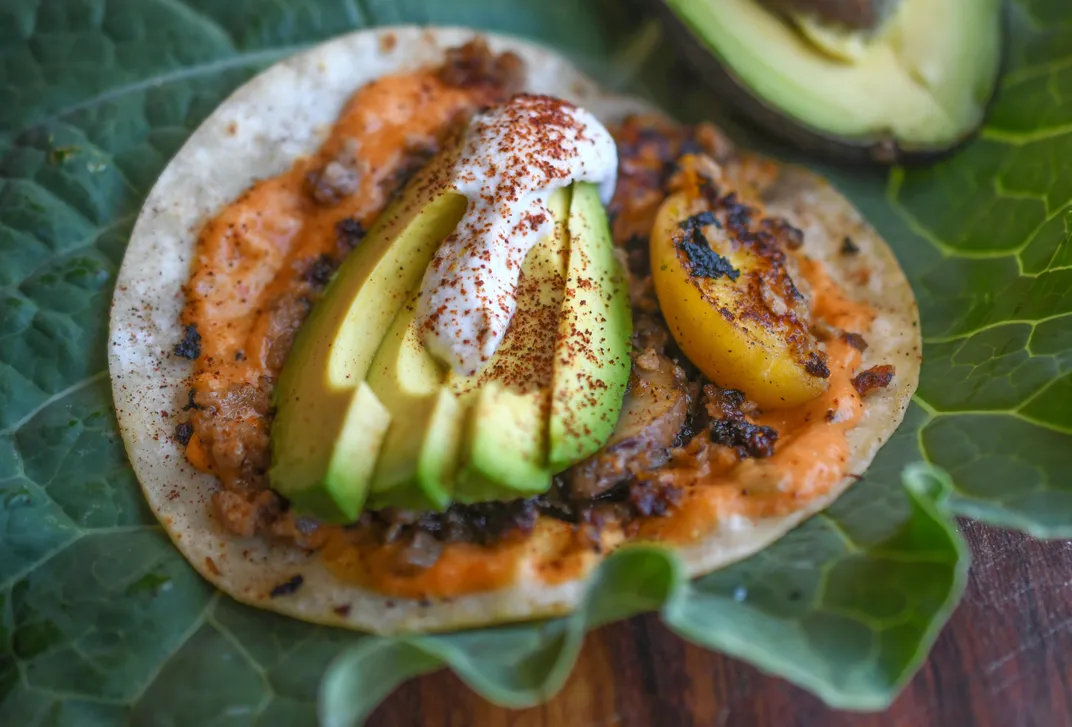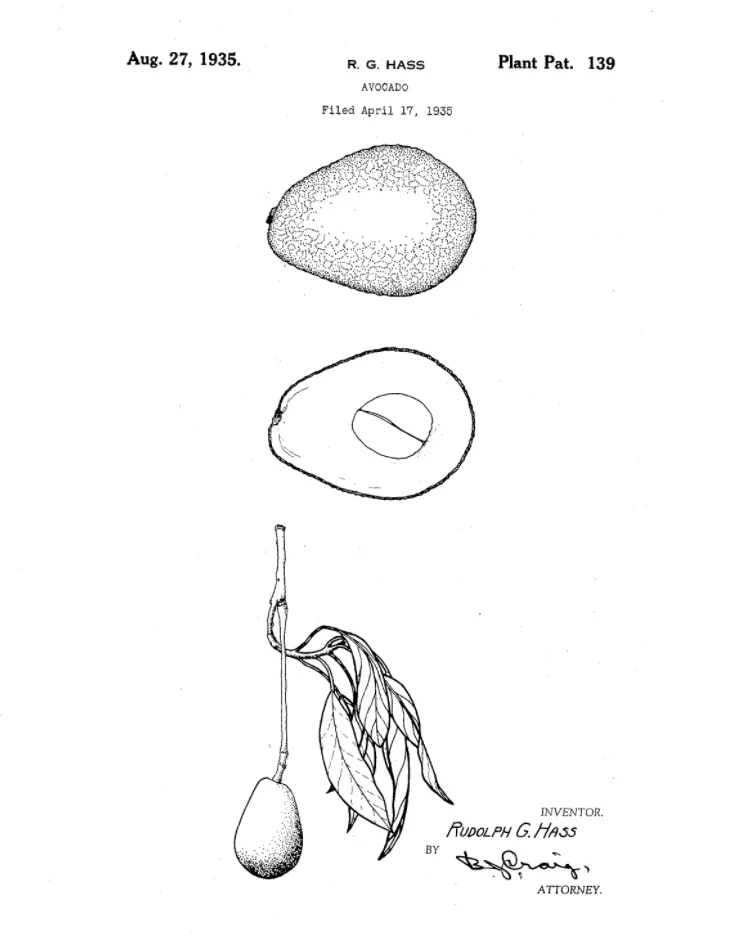Holy Guacamole: How the Hass Avocado Conquered the World
Why one California postman’s delicious mistake now graces toast and tacos from California to New Zealand
:focal(2218x1014:2219x1015)/https://tf-cmsv2-smithsonianmag-media.s3.amazonaws.com/filer/33/d6/33d66cbd-e525-4222-bb00-5495ec58a38d/bj3hyj.jpg)
Looking for a sign of the apocalypse? Consider this: Our global obsession with guacamole and avocado toast has helped spawn record avocado prices, financial woes for millennials and even an uptick in avocado-related crime.
Recently, three men were busted for selling off more than $300,000 worth of Hass avocados. They'd stolen the produce from the California agriculture firm that employed them, then passed them off at discount prices that seemed—and were—too good to be true. “Avocados are very subject to theft,” says Mary Lu Arpaia, a horticulturist and expert avocado breeder at the University of California at Riverside. “If you're not very honest, it's sometimes easy picking.” Call it Grand Theft Avo.
Such tales of produce-pilfering shouldn't be surprising, given that demand for the buttery fruit is at an all-time high. Americans devour 7 pounds of avocado per person each year, compared to 1 pound on average back in 1989. Per capita consumption of avocados has tripled since the early 2000s, according to the USDA. Yet nearly all of these avocados—some 95 percent in the U.S. and about 80 percent worldwide—are of a single variety: the ubiquitous Hass.
That’s especially crazy because, while people have cultivated avocados for thousands of years and come up with more than 400 different varieties, the pebbly, black-skinned Hass didn't even exist a century ago.
So how did Hass—which is pronounced to rhyme with “pass,” according to the Hass Avocado Board—come to dominate groves and dinner tables from California to New Zealand? As it turns out, the Hass avocado's story began with a delicious mistake.

But first, some ancient history.
Avocados were a popular snack food long before humans hit the scene. In the Cenozoic era, prehistoric megafauna like mammoths and giant ground sloths would gobble the fruit whole and then travel long distances, before pooping out the seed and thus dispersing the trees. Because of this animal-specific dispersion system, avocados might easily have vanished with those great mammals 13,000 years ago. But somehow, they survived.
By 500 B.C. humans were cultivating what they called ahuacatl in Mexico and Central America, breeding the fruit to have more and more of the delicious flesh they loved in the process. Ahuacatl was the Nahuatl word for "testicle," an apparent testament to the avocado's appearance when growing in pairs, and nod to its supposed properties as an aphrodisiac. Delicious!
But once avocados reached California in the mid-19th century, that name wasn’t going to sell. Not only were testicles not great for branding, but it was hard for North Americans to pronounce. ("Alligator pear," another early moniker, wasn't much better.) A little modification was in order. The Spanish used the term aguacate, and California farmers began promoting their own variation of that, "avocado," in 1915.
In 1926, according to legend and the University of California at Riverside, California postman Rudolph Hass brought some avocado seedlings home to grow on his La Habra Heights property. One defied repeated attempts to receive grafts from an existing avocado variety, bore no fruit and sorely tempted Hass to cut it down. But instead, he simply let the tree grow unattended.
It was the Hass children, according to the story, who discovered that the tree had produced a fruit that they liked far better than the others: one with a rich, nutty, slightly oily taste. Hass Sr. apparently concurred. “As I've heard the story, the kids brought the fruit in to him and he said, 'wow this isn't bad,'” Arpaia relates.
At the time, the reigning avocado variety was the Fuerte ("strong" in Spanish), which featured smooth, thin skin and an appealing green hue. By contrast, Hass’ experiment had a relatively unappetizing appearance, with thick, pebbly black skin. But Hass decided that it was what inside that counted—a decision that would change the course of avocado history.
It turned out that the Hass had some other big advantages over the Fuerte. The trees grow vigorously, are easy to propagate and produce an impressive amount of fruit by only the second or third year. They have a longer harvest season than other avocados and, perhaps most importantly, the Hass's thicker skin makes it superior to Fuertes, Pinkertons, Zutanos and other once-popular varieties when it comes to handling fruit and shipping it long distances.
Hass patented the tree that bears his name in 1935, and partnered with Whittier grower Harold H. Brokaw to promote the variety. Unfortunately, patenting a variety of fruit tree was nearly unheard of in his day, and therefore not very effective. Prospective growers would simply purchase a Hass variety and grafted it with other trees.
So while his name and fame spread widely with the tree, Hass and his family didn't really cash in on the craze that began in their backyard, son Charles Hass once explained to The Los Angeles Times. "For coming up with the greatest avocado in the world, my father's royalties totaled 4,800 bucks over the life of the patent," the younger Hass told the newspaper.
Hass Sr. passed away in 1952, but his creation far outlived him. The roots of this humble collaboration eventually populated the globe with millions of avocado trees, all genetically descended from that single mother tree that lived on at the old Hass place until claimed by root rot disease in 2002.

In 1945, avocado grower H. B. Griswold extolled many of the new fruit’s virtues in the California Avocado Society Yearbook. “From the market standpoint the Hass would appear to have everything. Excellent quality, popular size, small seed, good shipper,” he wrote. But Griswold also foresaw something that might limit the Hass’s success: “Its single disadvantage is its black color which has been associated in the minds of the public with poor quality fruits,” he wrote.
Thankfully, other growers weren’t as quick to judge the new avocado by its skin. When the industry expanded dramatically in the 1970s, Hass plantings led the way. Then, in the 1980s, the Hass's dark skin became a boon. That's when the industry began ripening avocados en-masse, believing that a ready-to-eat product would sell better. Avocados ripen off the tree, not on it. So by putting fruit in a 68 °F room and using ethylene gas to spark the fruit's own production of this natural ripening hormone, avocados could be brought to market ripe and ready.
Best of all, in the Hass's case, that meant they didn't show blemishes from handling damages like green-skinned avocados did. “The Hass's ripened, black skin hides about 90 percent of that,” Arpaia says.
Tim Spann, research program director for the California Avocado Commission, describes how the public was brought on board. “An early marketing campaign of the Commission was the 'Ripe for Tonight' program that helped to educate consumers outside of California about this new fruit and how to tell when it was ripe," he said. "This was done by talking about the built-in ripeness indicator—the black peel—and placing stickers on fruit at the point of sale that said, 'Ripe for Tonight.'"
The effort worked unbelievably well. Bob Bergh, Arpaia's predecessor at the helm of the avocado breeding program at Riverside, was charged with breeding a green-skinned Hass variety in the 1950s. When he finally succeeded in the 1980s, his Gwen avocado was too late. Just as black skin was once a liability, now green skin raised eyebrows.“Unfortunately by that time Hass had become the dominant variety and people said, 'what do you mean a ripe, green-skinned avocado? I've never heard of that,” Arpaia says.
Today some farmers still grow the Gwen, as well as other smooth-skinned green varieties from the Bacon to the Zutano. But they’re mainly enjoyed by local markets. California's 300-million-pound-per-year avocado industry is almost entirely given over to Hass production. It's the same story in Mexico, where the world's largest producer grows most of the avocados consumed in the U.S and ships more than 1.7 billion pounds north of the border each year.
The industry is so large that Mexican authorities are concerned about the industry's deforestation impacts. But experts like Arpaia are also worried about something else: that this monoculture is quickly displacing wild avocado species with the help of hungry humans. “I went to Chiapas, Mexico, one of the world centers for avocado diversity,” she recalls. “We had visions of seeing all these different types of avocados. What did we see? They were cutting down wild avocados and planting Hass trees.”
On the bright side, the success of the Hass variety has enabled avocados to become a global fruit, Spann notes, despite their rather limited growing range. Avocado trees require specialized tropical or subtropical climate because they tolerate neither freezing nor extreme heat, and less than 1 percent of California's land is suitable for avocado production.
“In California, for example, Hass fruit mature in about April on average, but because the fruit hang on the trees really well, we can continue harvesting into September or maybe even October in a really large crop year. Combine this trait with numerous producing areas—California, Mexico, Chile, New Zealand, South Africa, Israel—and you can supply the world year-round,” Spann says. “Essentially, Hass is the perfect avocado for the world market as we know it today.”
Arpaia concurs that the Hass has its benefits. But she also warns that we need new varietals, to stave of the hopefully remote prospect of an avocado Armageddon. When crops have little genetic diversity they become vulnerable to pests or diseases that are particularly well adapted to wipe out their specific type. One example is the way that that a fungus known as “Panama disease” decimated world banana production not once but twice in the 1950s and today, by targeting the varieties on which growers had come to rely.
Before you panic, let us be clear: no such threat appears imminent for Hass avocados. But if one were to appear, it could evolve and spread quickly, says Arpaia. “The whole world is marketing Hass,” she says. “It's very difficult to introduce new varieties right now. But I think down the road we need new varieties.”
…
On the flip side, it's possible that the avocado's unflagging popularity might actually help ensure its genetic diversity and continued success.
If foodies demand, and are willing to pay premiums, for other varieties, we could soon be seeing all manner of new avocados. “If you look at apples, Red Delicious still exists and is still a considerable part of the industry, but it was sort of a gateway apple and now consumers want to try other varieties to see what other flavor profiles are out there,” Spann points out. “I think in time the same will happen with avocados.”
Entirely new avocados will also emerge as experts like Arpaia continue to experiment with breeding. “The game is on to find something that's better than the Hass,” she says. “It's not perfect. For example, it's heat tolerant but not as heat tolerant as we'd like it to be.” A heat-loving Hass relative would allow California's space-strapped industry to expand into areas like the fertile Central Valley.
At this point, it’s hard to imagine most consumers accepting anything other than the Hass. But considering that avocado's own unlikely story—from prehistoric sloth meal to celebrated toast-topper—nothing can be ruled out. If a new avocado does someday spread across the globe, here's hoping its creators get to enjoy the fruits of their labor a bit more than Rudolph Hass.